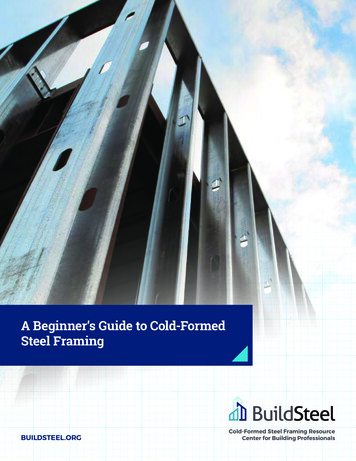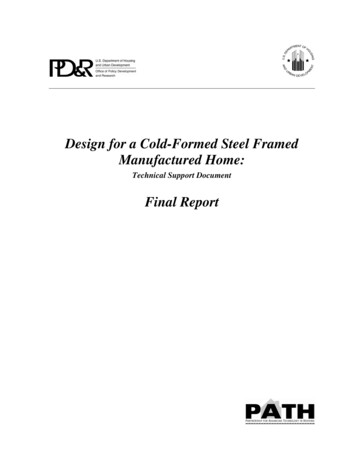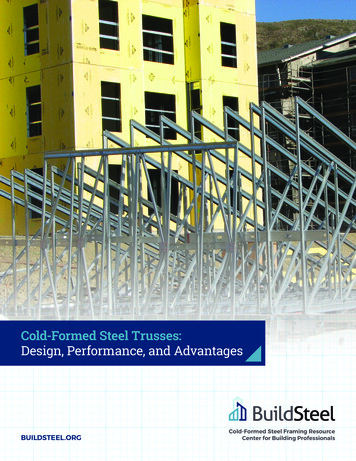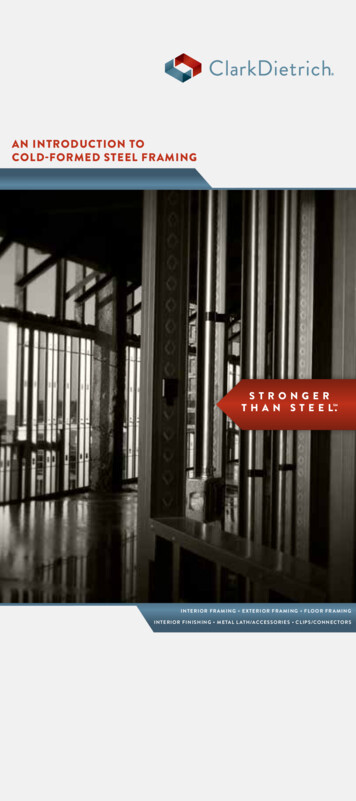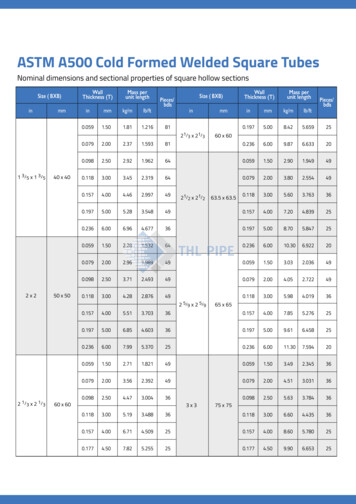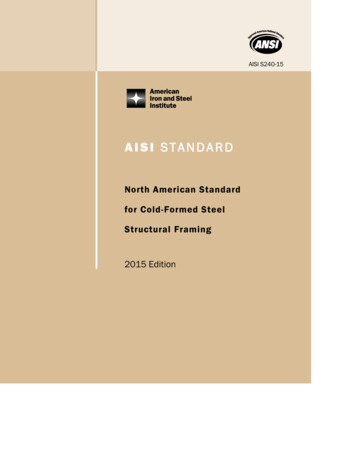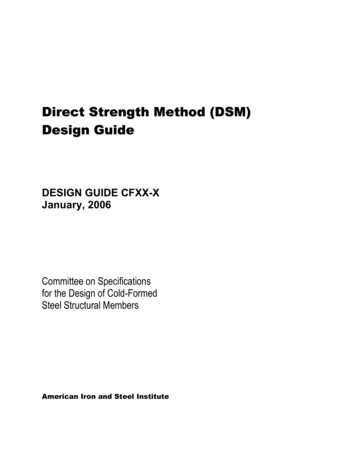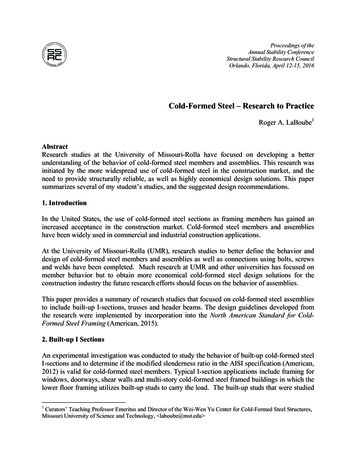
Transcription
Proceedings of theAnnual Stability ConferenceStructural Stability Research CouncilOrlando, Florida, April 12-15, 2016Cold-Formed Steel – Research to PracticeRoger A. LaBoube1AbstractResearch studies at the University of Missouri-Rolla have focused on developing a betterunderstanding of the behavior of cold-formed steel members and assemblies. This research wasinitiated by the more widespread use of cold-formed steel in the construction market, and theneed to provide structurally reliable, as well as highly economical design solutions. This papersummarizes several of my student’s studies, and the suggested design recommendations.1. IntroductionIn the United States, the use of cold-formed steel sections as framing members has gained anincreased acceptance in the construction market. Cold-formed steel members and assemblieshave been widely used in commercial and industrial construction applications.At the University of Missouri-Rolla (UMR), research studies to better define the behavior anddesign of cold-formed steel members and assemblies as well as connections using bolts, screwsand welds have been completed. Much research at UMR and other universities has focused onmember behavior but to obtain more economical cold-formed steel design solutions for theconstruction industry the future research efforts should focus on the behavior of assemblies.This paper provides a summary of research studies that focused on cold-formed steel assembliesto include built-up I-sections, trusses and header beams. The design guidelines developed fromthe research were implemented by incorporation into the North American Standard for ColdFormed Steel Framing (American, 2015).2. Built-up I SectionsAn experimental investigation was conducted to study the behavior of built-up cold-formed steelI-sections and to determine if the modified slenderness ratio in the AISI specification (American,2012) is valid for cold-formed steel members. Typical I-section applications include framing forwindows, doorways, shear walls and multi-story cold-formed steel framed buildings in which thelower floor framing utilizes built-up studs to carry the load. The built-up studs that were studied1Curators’ Teaching Professor Emeritus and Director of the Wei-Wen Yu Center for Cold-Formed Steel Structures,Missouri University of Science and Technology, laboube@mst.edu
consisted of two C-sections oriented back-to-back forming an I-shaped cross section. For eachspecimen, the studs were connected to each other with two self-drilling screws spaced at a setdistance. A track was connected running perpendicular to each end with a single self-drillingscrew through each flange of the C-sections. The purpose of the track is to keep the ends of thestuds together and represents a common end attachment. As a result of the investigation, thecurrent design requirements were found to be conservative in predicting the ultimate capacity ofbuilt-up studs (Stone and LaBoube, 2005).The American Iron and Steel Institute’s North American Specification for the Design of ColdFormed Steel Structural Members (AISI, 2012), AISI S100, stipulates design guidance forassemblies such as built-up compression members. The specification states for compressionmembers composed of two sections in contact that the nominal axial strength, Pn, shall becalculated as follows:Pn Ae Fn(1)Where Fn isFor inelastic buckling, λc 1.52λcFn (0.658 ) FyFor elastic buckling, λc 1.5Fn (2) 0.877 λ 2 Fy c (3)Where λc (Fy/Fe)1/2Fe π 2E(4)( KL / r ) 2If the buckling mode produces shear forces in the connectors between the members, KL/r shouldbe replaced with (KL/r)m. KL 2 a 2 KL r o ri r m (5)Where Ae is effective area at the stress, Fn, Fe is least of the elastic flexural, torsional, andtorsional-flexural buckling stress, E is modulus of elasticity, Fy is yield strength, K is effectivelength factor, L is unbraced length of member, (KL/r)o is overall slenderness ratio of entiresection about built-up member axis, a is intermediate fastener spacing and ri is minimum radiusof gyration of full unreduced cross-sectional area of an individual shape in a built-up member.An experimental study was performed at the UMR concentrating on the behavior of built-upcompression members, specifically I-sections (Stone and LaBoube, 2005). The purpose of theinvestigation was to assess the behavior of the built-up cold-formed steel compression membersand to determine if the present AISI S100 design methodology is valid for cold-formed steelmembers.2
The Structural Stability Research Council Technical Memorandum No. 4: Procedure for testingcentrally loaded columns (Galambos, 1998) provided basic guidance for the development of theexperimental study.Specimens tested in this investigation were constructed of C-shaped sections oriented back-toback with edge stiffened flanges and track sections. Figs. 1 and 2 illustrate typical C- and tracksections used in this study. All column specimens were nominally seven feet tall and the crosssection parameters of the C-sections used in this study varied as follows:Thickness, t: 0.84 mm – 1.37 mmDepth, D: 92 mm – 152 mmFlange, bf: 41.3 mmEdge Stiffener, df: 9.53 mmScrew Spacing, a: 305 mm – 914 mmFigure 1. Typical C-Section ParametersFigure 2. Typical Track Section ParametersThe built-up compression members were tested in a universal testing machine as shown by Fig.3.Figure 3. Test Setup3
Figure 4. Bottom Pin ConnectionSimulated pin-pin end connections were used in an attempt to achieve an effective length factorof unity. The bottom connection is illustrated in Fig. 4. The pin connection at the top of the studwas similar to the bottom connection in that the two plates had the same half-hemisphere.However, the upper plate in the top connection was connected to a load cell.The two C-sections were fastened together with screws through the web starting 50 mm fromone end and 19 mm from the inside of the flange. The screw spacing, a, was varied for the testspecimen, using spacing values of 305 mm, 610 mm, and 914 mm. The typical screw layout isillustrated in Figs. 5 and 6.A 305 mm long track section was screw attached to each end of the built-up I-section to simulatea typical industry application (Fig. 4).The load application consisted of centering the stud in the test fixture and applying acompression load through the center of gravity of the built-up member. The ultimate failureload, Ptest, was defined as when the test specimen was no longer capable of sustaining additionalload. Table 1 summarizes the failure loads. Although each test specimen was loaded until failure,some of the specimens experienced local buckling, but continued to carry load until the studformed a smooth curvature with the flanges buckling near mid-span and eventually failed asshown in Fig. 7.4
501910238a 305, 610, 914 mmFigure 5. Schematic of Screw Spacing and LayoutFigure 6. Typical Screw Spacing and LayoutFigure 7. Typical Failure Mode550
The recorded failure load, Ptest, for the 32 tests was first compared to the unmodified predictedfailure load, Pn, as determined by Section C4 of the AISI S100 without using the (KL/r)modification. Figure 8 illustrates the comparison of Ptest/Pn.Fig. 8 indicates that for the thicker materials the existing AISI design equations without using themodified slenderness ratio (Eq. 5) are conservative by an average of 43%. This suggests that themodification is not necessary for the thicker materials. The capacity of the thinner material (0.89mm) was slightly overestimated by an average of 1%, with five of the fourteen values being lessthan one.The recorded failure load, Ptest, for the 32 tests was also compared against the modified predictedfailure load, Pnm, as determined by Section C4 of AISI S100 using the (KL/r) modification (Eq.5). Fig. 9 illustrates the comparison of Ptest/Pnm.Fig. 9 indicates for the thicker materials the existing AISI design equations including themodified slenderness ratio (Eq. 5) are conservative by an average of 65%. This suggests that themodification is not necessary for the thicker materials. The capacity of the thinner material (0.89mm) was overestimated by an average of 16%; with only two of the Ptest/Pnm values less thanone. The test data indicates that the existing design specification provisions pertaining to theapplication of the modified slenderness ratio may be applicable for thinner members only.However, for all thicknesses, the AISI S100 stringent end fastener requirements are 0.40.80.911.11.21.31.4Material Thickness (mm)Figure 8 Test versus Computed Strength Using the Unmodifed KL/r6
911.11.21.31.4Material Thickness (mm)Figure 9 Test versus Computed Strength Using the Modified KL/r3. Cold-Formed Steel TrussesIn the United States, cold-formed C-sections are commonly used as roof truss members. The useof singly-symmetric sections and the connection arrangements used result in development ofbending effects in addition to axial loads in compression web members. At UMR, experimentalwork was carried out on full-scale trusses. The purpose of the research was to study the behaviorof cold-formed C-section truss chord and web members and to develop appropriate designrecommendations. A brief summary of the experimental studies and their findings are presented.3.1 Web MembersThe objective of the UMR experimental study was to evaluate the strength of the compressionweb truss members, to study their structural behavior and failure mode, and to develop a validanalytical model for analysis and design. A series of 20 tests fabricated using 64 mm deep Csections with thicknesses of 0.91, 1.19 or 1.40 mm were carried out on full-scale truss assemblies(Ibrahim et al., 1997). All of the trusses were fabricated using single C -sections and self-drillingscrews. The length of the compression webs were chosen to provide slenderness ratios (L/r) of100, 150 and 180.The maximum observed total truss vertical applied loads, at failure of the compression web, foreach truss, Wtest, are presented in Table 2. Failure of compression web was defined either bybending failure or when the transverse deflections became unstable. In no case did thecompression web show a torsional behavior.The predicted total vertical load applied on each truss was calculated for two different loadconditions. First, using the nominal axial load capacity for a concentrically loaded compressionweb member as the limiting load capacity, the total load on the truss, W*, was determined. Thetotal load on the truss, W, was also computed by using Eq. 6. When evaluating Eqn. 6, Pn* wastaken as the nominal flexural buckling capacity.C ( Pe)P 1.0 m PnM ny . α y7(6)
Where P is the applied axial load, Pn* is the nominal axial load, Cm is end moment coefficient, eis distance from centroid to outer edge of sections web, Mny nominal bending strength about theminor axis, 1/αy second order effect factor.Generally, Wtest exceeded W but was less than W*. Thus, Eq. 6 underestimated the load carryingcapacity of the web member, but ignoring the combined axial and bending behavior would beunconservative. This load correlation may be attributed to two conditions. First, the compressionwebs were observed to behave as beam-columns, not concentrically axially loaded members.Second, the eccentric nature of the load application forced a dominant the minor axis flexuralbuckling behavior. Therefore, flexural-torsional buckling was not a possible failure mode.The ratios between predicted and observed compression member axial loads P/Ptest (Table 2) alsoindicate a conservative trend. P is the computed axial load in the compression web when thetruss is subjected to total vertical load W and Ptest is the computed axial load at Wtest. For TestNos. 2, 3, and 8, the ratio P/Ptest was equal to 0.65, 0.64, and 0.57 respectively although differenttop chord rotational restraint conditions existed. Test Nos. 1 through 8 had an average ratioP/Ptest of 0.56, while the same average for Test Nos. 9 to 13 was 0.61 although different topchord stiffness existed. Therefore, it may be concluded that neither the rotational restraintconditions of the top chord nor its flexural stiffness had a significant effect on the capacity of thecompression web.A review of the data indicated that the ratios of P/P test (Table 2) seem to be related to theslenderness ratio L/r. Average values of P/Ptest for test specimens having L/r 100 was equal to0.58, with a standard deviation of 0.062, while for test specimens having L/r 150 and L/r 180the average P/Ptest ratio was 0.74, with a standard deviation of 0.081. Modification of Eq. 6 wassuggested as follows:C ( f .Pe)f .P 1.0 m PnM ny . α y(7)Where f is a reduction factor to account for the trend of P/Ptest (Table 3), and is a function of L/r.For L/r between 100 and 180, the reduction factor f may be computed using Eqn. 82L/r L/r f - - 0.22 0.8 88 173 (8)The last column in Table 2 shows the interaction values computed using Eq. 8. Considering thefact that in four tests, failure in the web member couldn't be achieved (Test Nos. 2, 3, 12 and 16)and in another four tests, the web member was capable of resisting more loads but with excessivedeflections (Test Nos. 14, 15, 19, and 20), it can be concluded that Eqn. 8 can be used safely forthe design of compression web members.3.2 Top Chord Concentrated Loading8
The objective of this phase of the UMR experimental study (Ibrahim et al., 1997) was to explorethe structural behavior and the failure mode of the top chord members under concentrated loads,and to develop a valid analytical model for the analysis and design. A series of twenty-eight testswas carried out on full-scale truss assemblies.All of the trusses were fabricated using C-sections and self-drilling screws. Eight differentprofiles of top chord cross-sections were tested. Each profile type had different materialthickness and mechanical properties. Concentrated load bearing lengths, N, of 51 and 102 mmwere used at the intermediate panel point.All trusses were load until failure. For 24 of the 28 tests, web crippling failures were observed atthe intermediate panel point of the top chord.An interaction formula was suggested in order to recognize the combined action of axialcompression, bending moment, and web crippling that caused top chord failure at the points ofload application. The total interaction, I, is calculated as follows:I MxPR PnoM nxRn(9)Where Pno is nominal axial load fully braced compression member, Mx applied bending momentabout the x-axis, Mnx is the nominal bending strength about the x-axis, R is the applied panelpoint concentrated load and Rn is the nominal interior one-flange loading condition webcrippling strength for a single web.Equation 9 is based on the common form of interaction equations of combined axial compressionand bending and combined bending and web crippling. Values of total interaction, “I" werecomputed by Eq. 6 for each truss assembly at the failure load. Values of I ranged from 1.27 to 1.77 with an average value of 1.49 and a standard deviation of 0.12.3. Header BeamsTo span openings header beams are commonly used in bearing walls framed with cold-formedsteel studs. Presented are the results of an experimental study conducted at the UMR to establishthe web crippling strength of both box- and I-beam headers for an interior-one-flange (IOF)loading condition (Stephens and LaBoube, 2003). The header beam specimens were tested as asystem consisting of two C-sections together with attached top and bottom track sections. Theheader configurations used in this study are defined in the North American Standard for ColdFormed Steel Structural Framing (American, 2015). Tested as a system, it was found that theweb crippling strength was greater than that for two independent, single web C-sections. Basedon the results of this study design recommendations were proposed.9
Figure 10 Box-Beam HeaderThe experimental investigation focused on testing of box-beam headers constructed as shown inFig. 10. All specimens were fabricated using industry standard material provided by threedifferent manufactures of cold-formed steel construction products.A total of 38 box-beam specimens were tested with either a single-point or multiple-pointloading as illustrated by Fig. 11. The length of bearing for the beam end reactions was 3-inches(76 mm) and 1 ½-inches (38 mm) for the IOF load points. Figure 11 shows a schematic of a testset-up for a specimen with two IOF load points.Fig. 11 Typical Test Specimen Loading Configurations10
For the box-beam specimens, based on analysis of the test results, it was determined that the ratioof track thickness to C-section thickness were key parameters that contributed to the increasedweb crippling strength of the box-beam header specimens and is represented by the followingrelationship between Pt/Pn and C-section to track thickness: t Pt 2.3 c Pn tt (10)Where Pn is the web crippling strength computed by using the AISI S100 equation, tc is thicknessof C-section and tt is thickness of top track.4. ConclusionsTo achieve more economical cold-formed steel solutions for the construction industry the futureresearch efforts should focus on the behavior of assemblies. This paper summarized pastresearch efforts that focused on the behavior of assemblies.For built-up compression members, a total of 32 specimens were tested for this study. Ananalysis of the data determined that for thicker materials the currently applied modifiedslenderness ratio was not necessary when computing axial capacity, and therefore the designercan use the actual slenderness ratio of the built-up member. Analysis of the data also determinedthat existing design specification provisions pertaining to the modified slenderness ratio may befollowed when designing thinner members. However, for all thicknesses, the AISI S100 stringentend fastener requirements are not warranted.The UMR research on cold-formed steel trusses focused on developing a better understanding ofthe behavior of truss assemblies. Based on the research findings, appropriate designrecommendations were developed for both chord and web members.The objective of the box-beam header experimental study was to develop a design methodologyfor conventionally framed box-beam headers subject to interior-one-flange web crippling loads.This was accomplished by experimental tests of headers as an assembly composed of two Csections and two track sections. Based on the tests carried out for this study, the nominal webcrippling strength for box-beam headers can be determined by using the AISI S100 webcrippling equation with a modifier that depends upon the thickness of the top track and the Csections.AcknowledgmentsMy success as a educator and researcher was possible because of the great mentors who guyedme and the great students and collaborators who made the journey so enjoyable.My introduction to stability research began with my Ph.D. study on the behavior of cold-formedsteel web elements subject to bending, shear and the combination of bending and shear. It wasmy Ph.D. advisor, Dr. Wei-Wen Yu, who taught me to always study research data and ask “Whatis the data teaching us?” Dr. Yu instilled in me an interest in cold-formed steel structures andtheir unique stability challenges. Thank you Dr. Yu!11
During my career I have been fortunate to have participated in countless cold-formed steelindustry activities that enabled me to benefit from interactions with many engineers who havemade substantial contributions to the cold-formed steel industry. Thank you members of theAISI Committee on Specifications and Committee on Framing Standards!The research work reported herein was conducted at the Department of Civil Engineering of theUniversity of Missouri-Rolla (now Missouri University of Science and Technology). I extendappreciation to the following graduate students whose work is summarized in this paper: Dr. T.M. Ibrahim, M. M. Harper, J. A. Riemann, Dr. S.F. Stephens, and T.A. Stone. Thanks are alsodue to the laboratory support staff of the Department of Civil Engineering, Mr. J. Bradshaw, Mr.J. McCracken, Mr. S. Gable, Mr. B. Swift, and Mr. G. Abbott for their assistance.Huge thanks goes to Ms. Christina Stratman, Administrative Assistant, who assisted me with thismanuscript and many previous manuscripts, conference proceedings and CCFSS projects.Finally, a very special thank you to my wife, Karen, and my daughters, Jennifer and Elizabeth,for your support and understanding especially when, on many evenings, I withdrew to my officeinstead of spending the evening with you. I love you!!ReferencesAmerican Iron and Steel Institute (2012). “North American Specification for the Design of ColdFormed Steel Structural Members,” AISI S100, Washington, D.C.American Iron and Steel Institute (2015), “North American Standard for Cold-Formed SteelStructural Framing”, AISI S240, Washington, D.C.Galambos, T. V. (Editor) (1998). “Guide to Stability Design Criteria for Metal Structures,” FifthEdition, John Wiley and Sons, Inc, New York, NYIbrahim, T.M., Riemann, J.A., LaBoube, R.A. and Yu, W.W. (1997), “Behavior of CompressionWeb Members of Cold-Formed Steel Roof Trusses,” Proceedings of the InternationalConference on Experimental Model Research and Testing of Thin-Walled Structures,PragueStephens, S.F., and LaBoube, R.A. (2003),“Web Crippling and Combined Bending and WebCrippling of Cold-Formed Steel Beam and Headers,“ Thin-Walled Structures, 41 (2003),Elsevier Ltd.Stone, T.A. and LaBoube, R.A. (2005,“Behavior of Cold-Formed Steel Built-Up I-Sections,”Thin-Walled Structure, 43 (2005), Elsevier Ltd.12
Table 1 Built-Up Compression Member Test 15215291491432.0335.3213
Table 2Truss Observed vs Computed LoadsTestNo.Predicted FailureAxial LoadsLoads(kN)in Web MembersWtestInteraction ValuesPIPtest(kN)W·WPPtestEqn (6)Eqn e0.642.491.03Standard Deviation140.18
investigation was to assess the behavior of the built-up cold-formed steel compression members and to determine if the present AISI S100 design methodology is valid for cold-formed steel members. n 2 0

